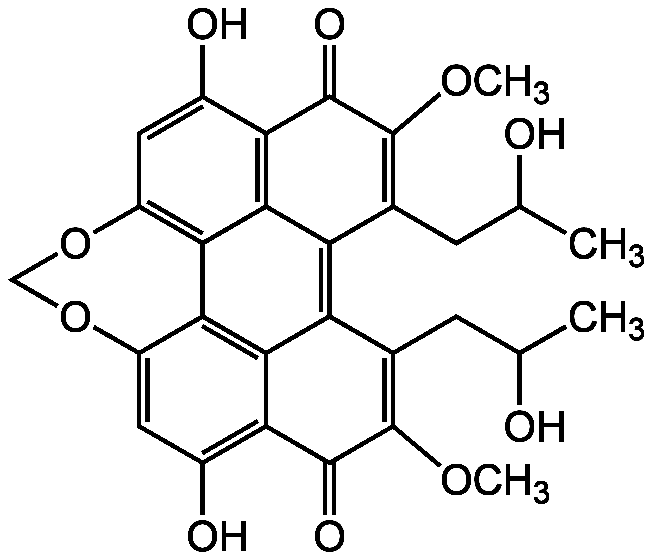Cercosporin
Product Code: AG-CN2-0111
Product Group: Natural Products and Extracts
Supplier: AdipoGen Life Sciences
| Code | Size | Price |
|---|
| AG-CN2-0111-M001 | 1 mg | £120.00 |
Quantity:
| AG-CN2-0111-M005 | 5 mg | £460.00 |
Quantity:
Prices exclude any Taxes / VAT
Overview
Regulatory Status: RUO
Shipping:
Ambient
Storage:
-20°C
Images
Documents
Further Information
Alternate Names/Synonyms:
NSC 153111
Appearance:
Dark red solid.
CAS:
35082-49-6
EClass:
32160000
Form (Short):
liquid
GHS Symbol:
GHS07
Handling Advice:
Keep cool and dry.
Hazards:
H302, H312, H332
InChi:
InChI=1S/C29H26O10/c1-10(30)5-12-18-19-13(6-11(2)31)29(37-4)27(35)21-15(33)8-17-23(25(19)21)22-16(38-9-39-17)7-14(32)20(24(18)22)26(34)28(12)36-3/h7-8,10-11,30-33H,5-6,9H2,1-4H3
InChiKey:
DGAZLNHJYDOWLG-UHFFFAOYSA-N
Long Description:
Chemical. CAS: 35082-49-6. Formula: C29H26O10. MW: 534.5. Isolated from Cercospora sp. Phytotoxin. Potent and specific PKC inhibitor. Competes for the phorbol binding site. Anticancer compound. Cytotoxic. Antiproliferative. Antiparasitic. Antimicrobial.
MDL:
MFCD32173762
Molecular Formula:
C29H26O10
Molecular Weight:
534.5
Package Type:
Vial
Precautions:
P261, P301, P312, P302, P352, P304, P340
Product Description:
Phytotoxin [1, 4]. Potent and specific PKC inhibitor. Competes for the phorbol binding site [2, 3, 6]. Anticancer compound. Cytotoxic [5, 6, 7]. Antiproliferative [5, 6]. Antiparasitic [7, 8]. Antimicrobial [8]. Photosensitizer, singlet oxygen 1O2 producer. Antimalaria
Purity:
>95% (HPLC)
Signal word:
Warning
SMILES:
COC1=C(CC(C)O)C2=C3C(CC(C)O)=C(OC)C(=O)C4=C(O)C=C5OCOC6=C(C5=C34)C2=C(C(O)=C6)C1=O
Solubility Chemicals:
Soluble in DMSO, ethanol or methanol.
Source / Host:
Isolated from Cercospora sp.
Transportation:
Non-hazardous
UNSPSC Category:
Natural Products/Extracts
UNSPSC Number:
12352200
Use & Stability:
Stable for at least 3 years after receipt when stored at -20°C.
References
Light-induced production of singlet oxygen and superoxide by the fungal toxin, cercosporin: M.E. Daub & R.P. Hangarter; Plant Physiol. 73, 855 (1983) | Calphostin (UCN1028) and calphostin related compounds, a new class of specific and potent inhibitors of protein kinase C: T. Tamaoki, et al.; Adv. Second Messenger Phosphoprotein Res. 24, 497 (1990) | Structural investigation of protein kinase C inhibitors: D. Barak, et al.; J. Mol. Struct. 230, 419 (1991) | Cell surface redox potential as a mechanism of defense against photosensitizers in fungi: C.C. Sollod, et al.; Appl. Environ. Microbiol. 58, 444 (1992) | Cytotoxicity and antiproliferative effect of hypericin and derivatives after photosensitization: A.L. Vandenbogaerde, et al.; Photochem. Photobiol. 67, 119 (1998) | Design, synthesis, and investigation of protein kinase C inhibitors: total syntheses of (+)-calphostin D, (+)-phleichrome, cercosporin, and new photoactive perylenequinones: B.J. Morgan, et al.; JACS 131, 9413 (2009) | Chemical constituents of the new endophytic fungus Mycosphaerella sp. nov. and their anti-parasitic activity: E. Moreno, et al.; Nat. Prod. Commun. 6, 835 (2011) | Antiprotozoal and antimicrobial compounds from the plant pathogen Septoria pistaciarum: M. Kumarihamy, et al.; J. Nat. Prod. 75, 883 (2012)



